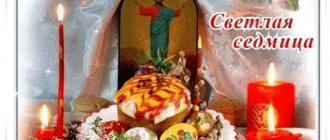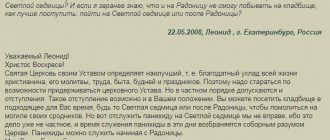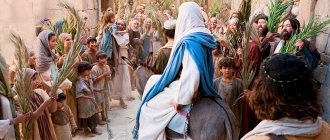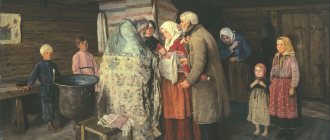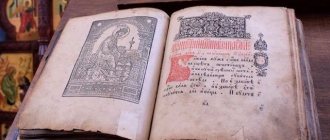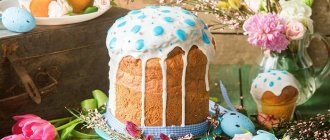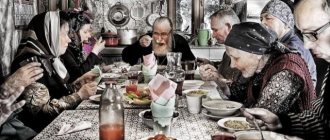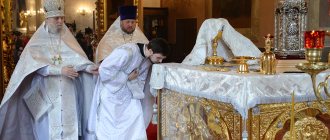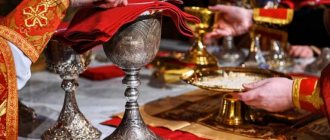Bright Week also has other names - Bright Week, Easter Week, Holy Week. In Orthodox Christianity, it lasts 7 days, begins on the feast of the Resurrection of Christ and ends on the first day of St. Thomas Week (the first week after Easter according to the Orthodox calendar).
On all days of Bright Week, festive services similar to Easter are held in Orthodox churches and temples. There are four services: Matins, Hours, Liturgy and Vespers. Throughout the entire week, the gates of the churches are wide open - until Bright Saturday, on which, after the liturgy, the artos is crushed and distributed. The Royal Doors are closed before the reading of the 9th hour, in the evening of Bright Saturday (before the start of the service).
The week after Easter is continuous; Orthodox Christians do not need to fast even on Wednesday and Friday, despite the sacrament. At the same time, it is not recommended to impose a fast on oneself even without permission. In Orthodoxy, throughout Bright Week, after the service, religious processions are held, at which believers sing festive chants, and the clergyman sprinkles everyone with holy water. At the moment of such a celebration, bells ring.
What date will be Orthodox Holy Week in 2022?
The beginning of Bright Week falls on the second day after Christ's Resurrection. In 2022 it is May 3. The holiday week lasts until Easter Sunday – May 9th. The first seven days after Easter in Orthodoxy are considered the brightest, purest and most joyful. During the entire period of Great Lent, the soul and body were cleansed from evil, filthiness and were filled with warmth. After the Bright Resurrection of Christ, the Orthodox rejoice; they celebrate the victory of Jesus over the evil that came from the kingdom of darkness. His resurrection and all his righteous people is a real miracle.
The clergy advise all their parishioners these days to drive away melancholy, sadness and anger.
It is during these seven days that deceased relatives from another world come to us to rejoice together in the resurrection of Jesus. These rules cannot be ignored - the most joyful event for the Orthodox world has happened and it must be honored. Interesting!
The funeral is held on Fomino Sunday, and the legend about the unbelieving Thomas is just about him. He did not believe in the Lord, but then he believed and became his follower.
Traditions
Our ancestors have long adhered to certain traditions, which it would not hurt for us to know. All forty days after Easter, it is customary not to say hello, but to greet people with the words “Christ is Risen.” In response, the believers answer: “Truly He is Risen.”
It has long been believed that fire can protect people from evil. Therefore, it is necessary to burn a cross on the doors with the fire of an Easter candle. This will allow you to ward all troubles and misfortunes away from home.
During Easter week, it is necessary to ride on a swing so that all misfortunes are blown away from a person. Previously, the birth of a baby on Easter or during the following week was considered great happiness. The Orthodox believed that the child would be healthy and happy all his life, and would grow up to be an extraordinary person.
On holidays it is good to hear the cuckoo cuckoo. The sign says that in this case the person will have good luck in all endeavors throughout the year. And young couples will certainly enjoy the happiness of motherhood and fatherhood. Girls of marriageable age who hear the cuckoo can count on getting married soon.
It is customary to bring colored eggs for remembrance and crumble them over graves, attracting birds. They were also poured with water to wash their faces to maintain the beauty of their faces.
Bringing the rose bush back to life after winter: how to properly reanimate flowers
An epidemiologist said whether re-vaccination with Sputnik V is possible
St. Petersburg and Sevastopol: regions with the greatest increase in crime named
According to signs, you should not have a wedding on Easter week. Temples do not perform wedding ceremonies at this time. To protect children from the evil eye and illnesses, after the holiday, mothers gave their children a piece of the blessed Easter cake throughout the week.
What kind of holiday is this?
On all days of Bright Week, fasts on Wednesday and Friday are canceled. After the festive joyful morning service, religious processions take place around the temple. Such a procession is reminiscent of the women who carried myrrh to the Holy Sepulcher. Believers follow the clergyman with lighted candles; the bell rings every day, starting from Easter Monday through Easter Sunday.
The sound of bells and the open gates to the altar indicate that justice has triumphed, the Savior has defeated death and opened the gates to the Kingdom of Heaven for his followers. The Church tells believers that these days they need to feel the grief of others and help their neighbors. This help is especially valuable in the first week after Easter, as the Lord brings goodness to the world with our hands. Any good deed must be selfless, come from a pure heart.
After a long period of fasting, a favorable period begins for marriages, engagements and romantic dates. After many restrictions, young people can finally go out and have fun. During the entire Lent, this is prohibited by the church. Despite this, the civil registration department registers marriages, but solemn weddings in the church are possible only on Bright Week and after it.
In the following table we will look at what is special about each day of this week.
| Day of the week | Description |
| Bright Monday | On the first day after Easter, people go to the morning service and praise the Savior. After it, the men go to visit with Easter cake baked by their wife and treat their relatives. Women are preparing a festive dinner at this time. On this day, girls wash themselves with water left over from dyeing eggs for the holiday - this way they can get beauty for the whole year. It is recommended to lightly beat sick and elderly people with branches of a consecrated willow - this way, the disease will recede. |
| Bright day Tuesday | On Tuesday, the service is also considered obligatory, but only women attend it. Men should stay at home, care for children and run the household. Oversleeping the ceremony is bad, as a person could cause trouble for the whole family. The evening of this day is usually spent in the family circle, you can go to visit good friends. |
| Bright day Wednesday | This day of the week is very important for unmarried young girls; they go to the service and ask the Almighty in prayer or words for help in creating a strong family. After the service they go for a walk; a new acquaintance promises a strong and long-lasting relationship for the couple. On this day, work in the field is prohibited; it was believed that there was a risk of damage to the plantings. |
| Bright day Thursday | On this day, according to tradition, people go to the cemetery and clean up the graves of their deceased relatives. At the same time, you should not be sad near burials, so as not to anger your ancestors. It is important to remember that their souls are in our world these days. |
| Bright day Friday | This day is intended for reconciliation with family and friends. On Bright Friday, the face of the Mother of God “The Life-Giving Spring” is venerated, therefore this date is recommended for the small rite of consecration of water. |
| Bright day Saturday | On Saturday the bells ring to mark the end of Bright Week. The morning after the service is spent visiting, and after lunch they begin cleaning the house. At church services, everyone present is given artos, a special bread. They take care of it at home until the next holiday of Christ's Resurrection and eat it when they are sick, believing that it has healing powers. |
| Bright day Sunday | The Day of Resurrection has a second name - Red Hill. It is customary to walk in the forest and in clearings, have friendly conversations, and declare love. |
Attention!
Not all traditions that existed before are still observed. It is rare for lay people to go to services on Monday, but the custom of visiting older relatives on this day has been preserved.
The traditions of the Sunday of Bright Week are being violated. According to tradition, it is customary to walk in forests and meadows, but people break it. They go to cemeteries, restore order and remember deceased relatives. This needs to be done on another day, on Radonitsa, which falls on May 11 in 2022.
Names from the people and the church calendar
Bright Week with its joyful and jubilant mood, cheerful rituals, supervision of brides, incantations and actions to achieve family peace and harmony, harvest, despite the outward carefreeness, is filled with great sacred meaning. It is reflected in popular beliefs and in church dates, in the names for each day:
- Bright Tuesday was called Bathing Day due to the fact that those who overslept the morning prayer were doused with water from a river or well. Unlike Monday, women went to visit, and men went to relatives. Games and festivities began, previously called Great Christmastide. Tuesday marks the Day of the Iveron and Shuya Icon of the Mother of God.
What you can and cannot do on Bright Week
Bright Week is a period of joy. Before Easter there was a fast, introducing strict restrictions and prohibitions on fun and any entertainment. This week they are removed for Orthodox Christians, so you can unwind. During this period, you should try to visit temples and churches more often due to holiday services; the laity should better try to have time to confess and receive communion.
You cannot be sad or despondent at this time, and this recommendation applies not only to thoughts, but also to actions. If there is anxiety lurking in your soul, you need to have a sincere conversation with a clergyman to find out what is wrong with your soul. During this period, the church imposes a ban on prayers for the dead, but it is lifted if the person died during this time. Funerals and funeral services are always held.
Bright Week is a festive time, so every person can rejoice and have fun, but while doing this, one must try to scatter goodness around oneself. If such a celebration disturbs anyone, he must be humbled, trying to be quieter. The main thing is to understand that Easter and the first week after it are a time of celebrating the triumph of life over death and good over evil.
Signs related to weather
Our ancestors, in times without the Hydrometeorological Center, determined the weather and harvest by signs:
- if all the days of the holiday week are warm and clear, then the summer promises to be hot and dry, and the autumn – fruitful;
- a cold summer should be expected if the sky is overcast and overcast throughout the week after Easter;
- even one thunderstorm in the week after Easter foreshadows a late autumn without rain;
- heavy rains after the Great Resurrection - to a rich harvest.
What can you eat on Bright Week after Easter?
At this time, it is better to have time to confess and take communion; breaking the fast is considered an optional attribute of the Easter fast. Lay people observing Lent can eat whatever they want during this period: traditional Easter cakes (butter cakes), Easter cottage cheese, chicken eggs, meat, fish and other products. There are no dietary restrictions during this time.
But parishioners should take into account that the clergy of churches advise observing moderation in everything and not turning this happy time into a continuous celebration. The consumption of alcoholic beverages these days should be, if not excluded, then radically limited. You shouldn’t deny yourself fun and entertainment, but there should be moderation in everything.
What is meat-eating week and when will it occur in 2022?
Archpriest Alexander Ilyashenko explained that in the Church Slavonic language it is customary to call a “week” not a seven-day period, but specifically a resurrection. Another word used to refer to the week is “week”. But Sunday is called meat week. Another church name is the Week of the Last Judgment.
The meat-eating week begins on the penultimate Sunday before Lent. This is the last day when believers can still eat animal products. But during the next week (Maslenitsa week) you will be able to eat dairy products, cheese, eggs, but not meat.
This year, Meat Week falls on February 27th.
How to take communion after Easter on Bright Week
Taking communion on Bright Week is allowed and even recommended; this is stated in the rules of the Ecumenical Council. These recommendations advise the laity to undergo the ritual daily during the week after Easter. Now this is impossible, so within 7 days you need to find at least one and have time to attend the service.
If a Christian has spent the entire period of Lent in prayer and complete abstinence from impurity, gluttony and adultery, it is advised to take communion on an empty stomach, but without fasting on Easter. At Matins on Monday after Easter, before the liturgy, the Paschal canon of the hours of Easter and the Follow-up to Communion is read. It is not necessary to receive communion on Holy Week. The main thing is that the parishioner should not have serious sins without repentance.
Attention!
The need for confession before communion is determined by the parish confessor. If the clergyman considers this process necessary, one should not insist otherwise.
Bright Week is the seven days following the main Orthodox holiday of Easter. Each of them has its own significance in the Orthodox Church. Each date, as well as the days of Holy Week, has its own explanations - the commandments state exactly how lay believers should spend this day. The main thing at this time is to be in an exalted mood; one must rejoice in the victory of Jesus in the darkness, while not being carried away by earthly sins. This is the best period for confession before the Lord and communion.
Radonitsa
We mentioned earlier that during Easter week you should not remember the deceased or order memorial services. After Bright Week, Thomas Week begins, during which, on the contrary, it is necessary to remember the departed. It is believed that true believers should not fall into despondency and melancholy. The thoughts of Christians should remain bright, because the departed find eternal life in God's Kingdom. Joy for their souls should crowd out sadness from the heart.
On Tuesday of Saint Thomas Week, Radonitsa is celebrated. On this day it is customary to remember the dead. From Radonitsa you can start ordering memorial services in churches. On this day it is necessary to visit the graves of relatives. If necessary, it is necessary to clean up the cemetery and paint the fence and monument. On Radonitsa it is customary to remember the dead. Some do it right at the cemetery. There is no consensus regarding the correctness of such actions. There is nothing wrong with remembering the dead in a cemetery, but in this case you should not drink alcohol so as not to desecrate their memory. It is necessary to respect the place where the dead are buried. In the cemetery you cannot swear, smoke, or talk loudly.
Tested for generations: we make effective fertilizing for seedlings
The craftswoman showed how she uses egg trays (and there’s no shame in giving them as a gift)
Seedlings will grow by leaps and bounds, literally and figuratively: effective feeding
Artos. Bread
Artos is the name of sourdough bread with the image of the Cross or Resurrection of Christ. “Artos” translated from Greek, in fact, means “leavened bread.” It is consecrated on the first day of Easter and throughout Bright Week stands on a lectern (a special table) in front of the icon of the Savior, to the right of the Royal Doors. And when there is no service - right in the gates, which open just enough so that a lectern with an artos can fit in its doors. The tradition of carrying out the artos during the daily religious processions during Bright Week is preserved.
Why is all this needed? According to one version, this custom goes back to the apostolic tradition: when Christ’s disciples gathered for a meal after His Resurrection, according to legend, they placed part of the bread on the table for Him, as they always did during His earthly life. In monasteries, this tradition continues to live in its original form: all week long, artos is brought to the refectory and placed on an unoccupied place at the table or on a separate table.
Artos today symbolizes the invisible presence of Jesus Christ with us. At the same time, this is a symbol of eternal life: I am the bread of life; He who comes to Me will not hunger (John 6:35), as the Savior said about himself.
Photo by Yulia Kuzenkova
Artos is distributed on Saturday of Bright Week, after the morning service. It should be eaten on an empty stomach and in special cases, for example, in illness.
